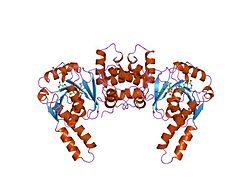| 3-hydroxyacyl-CoA dehydrogenase | |||||||||
|---|---|---|---|---|---|---|---|---|---|
 (S)-3-hydroxybutyryl-CoA dehydrogenase homodimer, Cupriavidus necator | |||||||||
| Identifiers | |||||||||
| EC no. | 1.1.1.35 | ||||||||
| CAS no. | 9028-40-4 | ||||||||
| Databases | |||||||||
| IntEnz | IntEnz view | ||||||||
| BRENDA | BRENDA entry | ||||||||
| ExPASy | NiceZyme view | ||||||||
| KEGG | KEGG entry | ||||||||
| MetaCyc | metabolic pathway | ||||||||
| PRIAM | profile | ||||||||
| PDB structures | RCSB PDB PDBe PDBsum | ||||||||
| Gene Ontology | AmiGO / QuickGO | ||||||||
| |||||||||
| Hydroxyacyl-Coenzyme A dehydrogenase | |||||||
|---|---|---|---|---|---|---|---|
 PDB rendering based on 3had. | |||||||
| Identifiers | |||||||
| Symbol | HADH | ||||||
| Alt. symbols | HADHSC | ||||||
| NCBI gene | 3033 | ||||||
| HGNC | 4799 | ||||||
| OMIM | 601609 | ||||||
| RefSeq | NM_005327 | ||||||
| UniProt | Q16836 | ||||||
| Other data | |||||||
| EC number | 1.1.1.35 | ||||||
| Locus | Chr. 4 q22-q26 | ||||||
| |||||||
In enzymology, a 3-hydroxyacyl-CoA dehydrogenase (EC 1.1.1.35) is an enzyme that catalyzes the chemical reaction
Contents
- (S)-3-hydroxyacyl-CoA + NAD+ 3-oxoacyl-CoA + NADH + H+
Thus, the two substrates of this enzyme are (S)-3-hydroxyacyl-CoA and NAD+, whereas its 3 products are 3-oxoacyl-CoA, NADH, and H+.
This enzyme belongs to the family of oxidoreductases, to be specific those acting on the CH-OH group of donor with NAD+ or NADP+ as acceptor.

